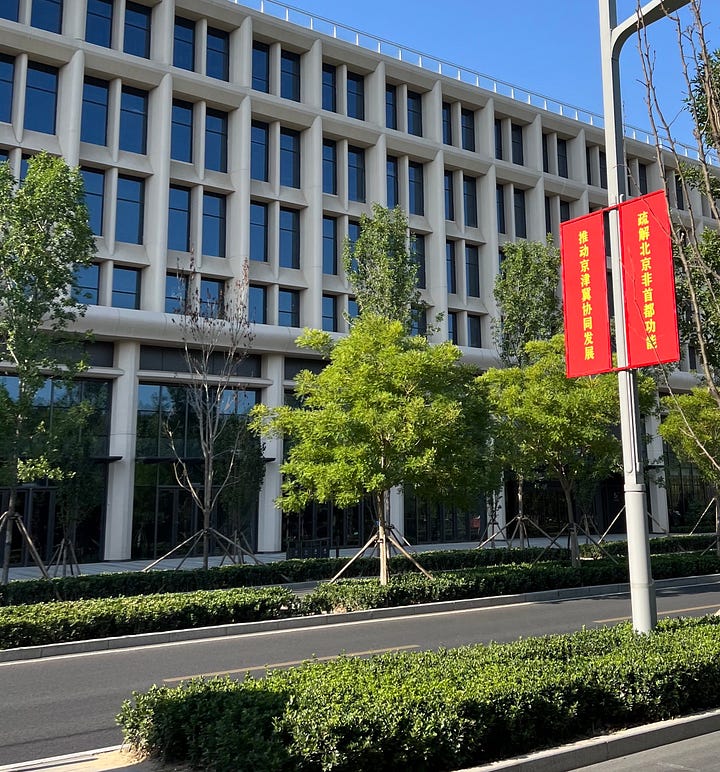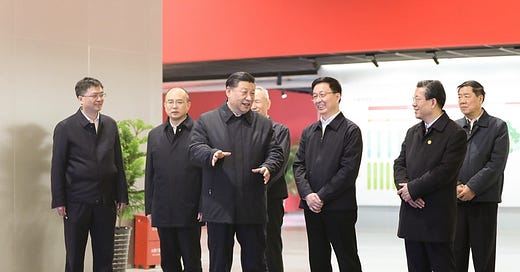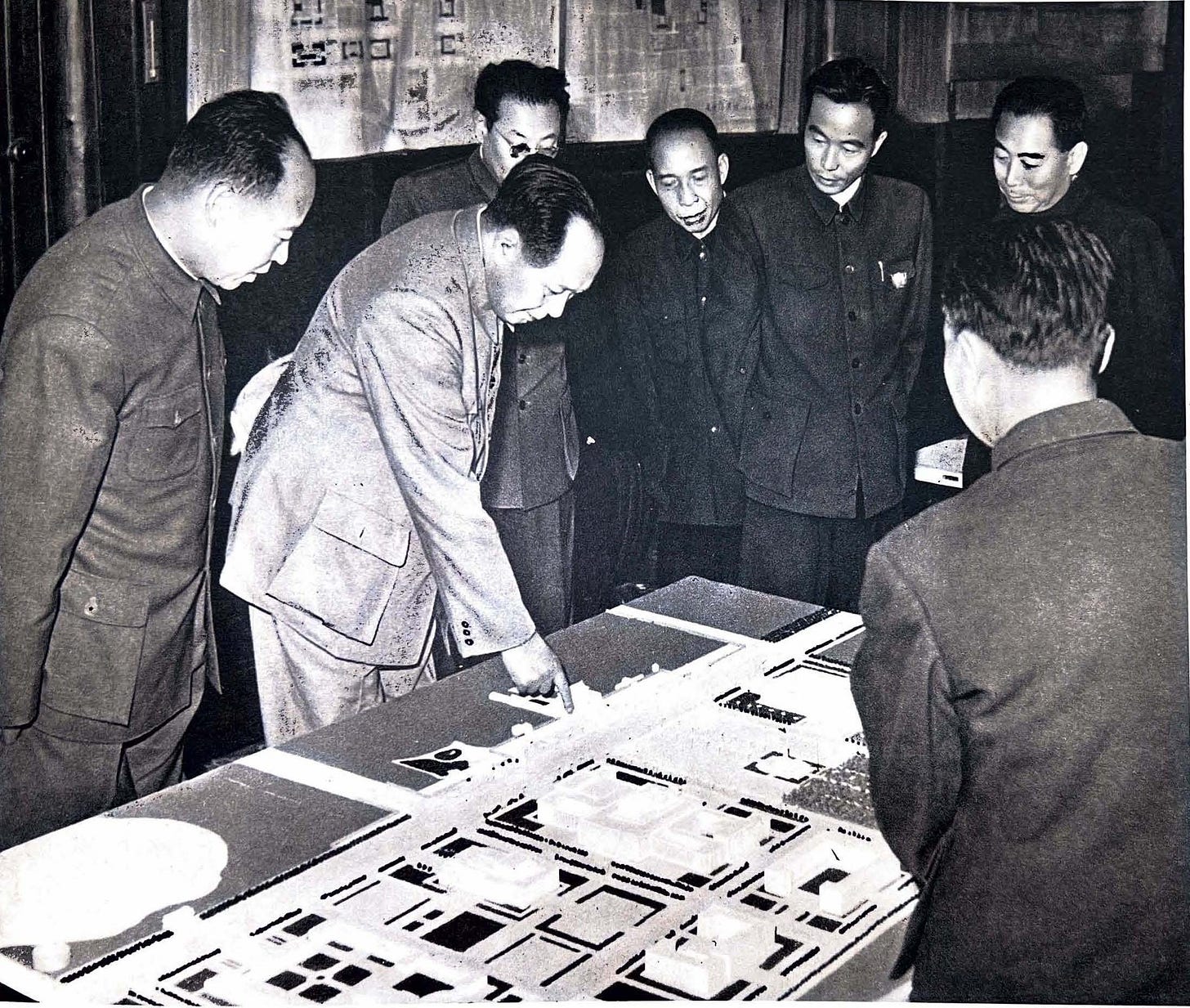Xi Jinping, the urban theorist
Powerful leaders in China and elsewhere have often taken an interest in city building. What are Xi's thoughts on urban development and why do they matter?
In remarks in 2013, Xi lamented that “today, when you go to many places, it’s all big roads, big squares, big green areas, big parks, but the land use efficiency is low; things look strong on the outside but dry inside; farmland has been sold off, the city’s produce comes from further and further away.”1
This is just one of the gems of wisdom in the collected speeches of Xi Jinping on urban development that I managed to pick up last summer at Xinhua Bookstore’s flagship branch in Beijing’s Wangfujing. Of course, authoritarian leaders in the mold of Xi tend to opine on any number of topics that they themselves are not experts in. But Xi’s views on cities and urban planning can hardly be described as radical. Rather, they can be characterized as countering the problems that emerged from China’s breakneck urbanization in the Reform Period: pollution, loss of local identity, overpriced housing, traffic jams. There has been a constant emphasis on quality of life and convenience, over economic growth and development at all costs, and a return to emphasizing local culture and identity. And there is a predilection for integrated planning, order and control, which are seen as necessary to counter some of the chaotic problems of poor construction, pollution, and other “urban sicknesses” 城市病 that have sprouted in China’s cities.
As a leader of small counties and provinces in China from Hebei to Zhejiang and Fujian, Xi has had his share of experience in urban development. One of the first things he did as Party Secretary of the rural county of Zhengding in Hebei province (1982-1985) was to use his family connections to persuade CCTV to build a set there to film a TV series based on the Chinese classic Dream of the Red Mansion. After the show aired and became a hit in 1987, the set became a popular tourist spot, attracting half a million tourists to Zhengding2. Xi cut his teeth in China’s bureaucracy through successful local entrepreneurialism, as many leaders have. Perhaps this was a formative experience in the role that local culture and traditional heritage could play in economic development. However, during his tenure as Chairman, Xi has in fact taken aim at the autonomy and local entrepreneurialism that characterized China’s Reform and Opening Up Period, and the urban and architectural chaos (some might say vibrancy) that resulted.


Here are a few more of Xi’s thoughts on cities, mostly taken from the book below, as well as a few other sources. These ideas may not have all been written by Xi personally, but taken together they do present a picture of an “urban ideology” characterizing the Xi era, peppered with a number of slogans and ideologies that put improving urban life at the center of the party’s governing agenda:


Controlling fragmented urban governance
Xi’s opinions on cities and urban planning are and have mattered for his policies over the years. Xi’s centralization of power within the Party is paralleled by a vision for greater geographic centralization of power, away from prefecture-level cities (地级市) and towards provincial or national level bodies. This is seen in the 2014 "New Type Urbanization Plan” calling for greater cross-provincial coordination of regional and megapolitan planning, as well as more recent efforts to create a unified national digital spatial plan or what is called 一张图, and his ongoing interest in the Jing-Jin-Ji plan, adopted in 2015.
“New cities and new districts emerge in an endless stream, and large-scale demolition and construction continue all year around…some leaders and departments replace the rule of law with administrative orders, illegally intervening in urban planning, construction, and management. Some cities have the phenomenon of ‘one secretary for one city, one mayor for one new district.” (一任书记一座城 一个市长一新区)—2015 Central Urban Work Conference remarks (December 20, 2015)
No Weird Architecture: Cities, Cultural Self Confidence, Local Identity
Xi’s first widely publicized broadside against China’s architecture and urbanism came in 2014 when, during a symposium for writers and architects, he lamented that much of contemporary art had lost its connection from the masses and was pursuing “luxury, over-packaging, and form greater than content.” Such a broadside was the first major indication of Xi’s broader push for cultural conservatism and his increasing emphasis on traditional Chinese culture, or what has been called 优秀传统文化 “excellent traditional culture”, alongside “Red culture” or 红色文化。This view extended to architecture as well, with subsequent critiques of flashy buildings built by Western starchitects including Rem Koolhass’s CCTV building in Beijing or the “big pants”, or Paul Andreu’s massive egg, the National Opera Hall near Tiananmen Square. This marked a profound shift for China’s architectural industry, one in which Chinese traditional elements and understated classicism would be favored over daring contemporary projects that in Xi’s view, just aimed to attract attention.
“A nation (minzu) requires a national spirit, and a city also requires a spirit of the city. The urban spirit should reflect the characteristics of a city. We should combine our own historical heritage, regional culture, and the requirements of the times to create our own urban spirit..” (Dec 20, 2015), pg. 110
“Some cities have chaotic phenomena such as greed for size, flattery of foreign countries and pursuit of strangeness. Some strange buildings have sprung up, and some cities have even become testing grounds for foreign designers’ ‘wonderful ideas’” (Remarks given at the Central Urban Work Conference, Dec 20, 2015), pg 29
Better Planning and Coordination
“As the ancients used to say, ‘the city is the reason for the prosperity of the people (城所以盛民也), urban development requires integrating production space, living space, ecological space, realizing an effective production space, liveable living space, with “green mountains and water”
Unsafe construction
“The short life of buildings is a common problem across many of our cities. Now, many cities are demolishing buildings built in the 80s and 90s, and poorly built buildings today will meet the wrecking ball in the near future. The city’s safety situation is not optimistic—people drowning in sewers and being crushed to death by building collapses, fire disasters, “crooked buildings, fragile buildings, and collapsed buildings” continue to appear. As the scale of cities expands, urban systems are becoming more and more complex and social risks are increasingly concentrated in cities.” (“Basic Ideas for Doing a Good Job in Urban Work”, Dec 20, 2015), pg. 83
Cities for People 人民城市为了人民
“Cities belong to the people. Urban construction should implement the people-centered development concept to make people’s lives happier. Gold and silver bowls are not as good as the public’s praise. Only when the masses say its good is it truly good.” -’Speech during an Inspection Tour in Gansu’ (2019, August 19)’
“The core of cities are people, the important points can be summarized in 12 characters: 衣食住行, 生老病死, 安居乐业 (clothing, food, living, working, Birth, aging, illness and death, live and work in peace and happiness. The important standard of city management and service is whether the people are satisfied, is life convenient of not?” (做好城市工作的基本思路) Dec. 20, 2015 (pg. 82)
Xiong’an: the embodiment of Xi’s architectural tastes
Wandering through Xiong’an New Area on a hot summer last year, the words of Xi were everywhere, mostly in the form of quotes on red banners hanging from almost every lamppost, and on large purpose-built block character signs: one large sign in Xiong’an’s Rongdong District reading “all of the country’s great accomplishments are a result of the people and the party working and struggling together.” On another, Xi’s quote about the value of environmental protection “Green waters and green mountains are mountains of gold and silver”(绿水青山就是金山银山). But Xi’s architectural tastes were also literally embedded in the form of the buildings around me. A Chinese classmate of mine from Harvard’s GSD who had worked on Xiong’an’s master plan for SOM told me that “from the beginning all of these architectural guidelines were given: avoid glass curtain walls as much as possible, more natural materials like stone and wood. Buildings heights would be controlled.” The official master plan for the city adopted in 2018 calls for “a fusion of Chinese and architectural styles with Chinese leading.” (中西合璧,中为主). Many of the residential buildings are rather generic and not explicitly Chinese, but the parks and open spaces have many traditional pavillions and pagodas, with one even constructed with expensive and heavy bronze cladding.




Social Services
“Cities are for people. We should create more places for citizens to relax, sightsee, and exercise, so that people’s lives will be more convenient and colorful. We should push the focus of social governance to the grassroots level, put more resources, services, and management into the community, and better provide community residents with precise and refined services. “ (Inspection tour in Shandong, June 12-14, 2018)

Conclusions
These passages offer a glimpse into the views of Xi on cities and urban development. Xi has strong thoughts and criticism of the way cities went about development in the post Deng era—criticizing the lack of planning, rush for profit over livability, and neglect of urban culture and ecological preservation. Xi’s view on cities have been an important aspect of his effort to remake urban governance in China. Efforts to centralize urban governance are part of an overall centralizing turn to reduce the autonomy of cities across a variety of dimensions. Whether Xi will be able to preside over further reforms to urban governance, such as hukou reform, or actually getting cities to adopt more sustainable fiscal systems and provision of public services will be a test of whether Xi’s ideas about cities are put into practice.
“Remarks given in December 2013 at the Central Urbanization Working Group Meeting” Central Party Research Institute (2023) Xi Jinping guanyu chengshi gongzuo lunshu gaopian “Excerpts of Xi Jinping’s Discussion on Urban Work” Central Document Publishing, Beijing, pg 69-79
https://www.guancha.cn/culture/2017_01_23_391002.shtml?web









Fascinating
I recognize 许勤. Who are the other leaders?